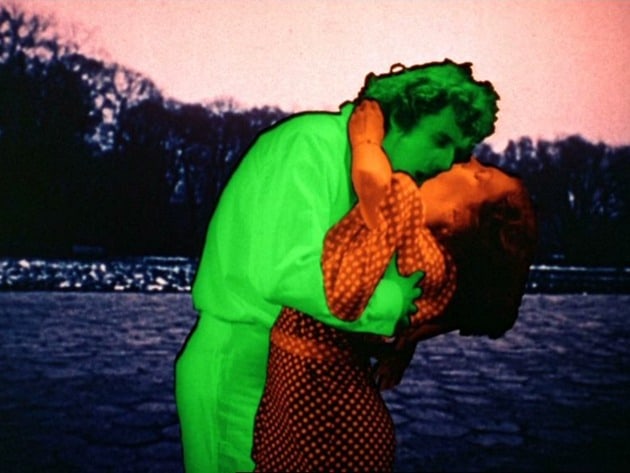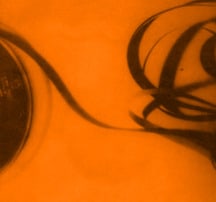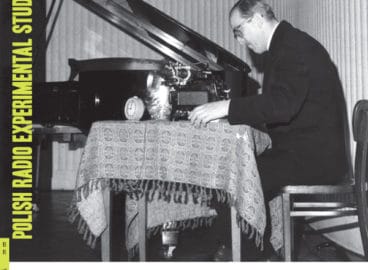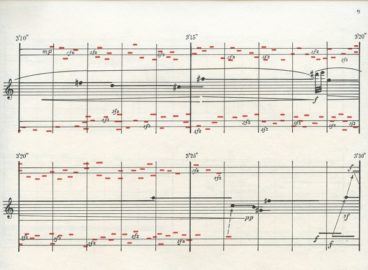This text was originally published under the theme “Polish Radio Experimental Studio: A Close Look”. The theme was developed in partnership with Muzeum Sztuki, Łódź (MSŁ). It was edited by Magdalena Moskalewicz, MoMA with Daniel Muzyczuk, MSŁ. The original content items in this theme can be found here.
Producing sound effects for radio, film, and television propagated new trends in audio art. Whereas concerts of autonomous music organized by Polish Radio attracted audiences of a few dozen people, popular new movies pulled in far larger crowds.

In the popular children’s movie1Based on Jan Brzechwa’s 1946 novel. The film can be viewed on youtube (accessed June 15, 2014). Akademia Pana Kleksa (Mister Blot’s Academy, 1984) about a boys’ boarding school run by the eponymous Mr. Blot, there is a haunting scene involving a pack of wolves seeking revenge. The wolves sing a scary song that was performed for the soundtrack by the Polish heavy metal band TSA. Even more frightening than the song and the animals’ sinister, anthropomorphic appearance are the strange hissing sounds evoking lupine speech. If someone were to ask me to name an emblematic example of Polish electronic music in the service of cinematography, I would choose the sounds that Bohdan Mazurek created for that scene with the wolves, which haunted me for months. Eerie effects like these were what many filmmakers were after when they commissioned work from Polish Radio Experimental Studio (PRES).
Even though most of our generation growing up in the 1980s first encountered PRES through productions such as Akademia Pana Kleksa, the work the Studio carried out for the radio and film industry has not yet received serious analysis. This lapse is particularly surprising since the autonomous electronic music production for which PRES is renowned grew out of the same experimental environment where soundtracks for radio, TV, and film were created. Aiming to heighten the credibility of actions unfolding in radio dramas and films, PRES sound engineers used various novel techniques—tape manipulation, added reverberation—that in some cases resulted in miniature musical compositions. Just as French musique concrète pioneer Pierre Schaeffer drew on his experience in radio production when developing his experimental sound techniques, the production of autonomous electronic music at PRES owed much to its engineers’ experience working on projects rooted in other media.
Building the Basics
Before PRES was established in 1958, soundtracks made for Polish Radio productions were recorded in Warsaw University of Technology’s Department of Electroacoustics and then produced in Warsaw’s Documentary and Feature Film Studio (WFDiF). The composer Włodzimierz Kotoński worked with those two institutions when making the soundtracks for Barwy radości i smutku (Colours of Joy and Sadness, 1957), Ryszard Golec’s documentary film about the painter Zbigniew Kupczyński, and Dom (House, 1958), an experimental film by Jan Lenica and Walerian Borowczyk. The production of Barwy relied on an array of catchy tricks. For example, Kupczyński is filmed through a glass plate on which he paints with his trademark, vivid colors. In Dom, which employs a plethora of animation techniques, sound plays a key role, guiding the viewer through the narrative. Indeed, for me, Dom’s soundtrack is essential: if I watch the film with the sound muted, I lose all sense of orientation. Moreover, the electroacoustic passages always occur at moments when various objects are brought to life. The composer not only endows these objects with a voice but also with something like a soul, since their individual characters can be discerned from the sounds they emit.
The very first production executed at PRES was the soundtrack by Kotoński, who was by then affiliated with the Studio, to the film Albo rybka… (A Fish or…, 1958), by leading Polish animators Hanna Bielińska and Włodzimierz Haupe. The striking electroacoustic effects harmonize with the filmmakers’ surrealistic motifs. As Kotoński himself later wrote, his aim was to create an “integral soundtrack” in which the surrealist sounds combined to form a kind of meta-music. Kotoński was so intrigued by the manipulation of recorded cymbal sounds that, after completing Albo rybka…, he embarked on what would be the first autonomous tape piece produced in Poland, Study for One Cymbal Stroke (1959). Conceived in the spirit of total serialism, the work was produced by manipulating in multiple ways (filtering, transpositions and tempo alterations, etc.) a recording of the sound produced by a cymbal when struck just once by a soft stick.
As noted above, PRES had the dual mission of producing radio and TV soundtracks in addition to autonomous pieces of music. Such was not the case at cutting-edge electroacoustic studios in Cologne and Paris, where electronic music—indeed music of any kind—made for film, radio dramas, and television was regarded as subservient to words and images, and therefore held in low esteem. In London, however, critics and producers recognized the dramatic potential of electronic music and likened the bizarre dissonance of its language to sounds of rage, madness, and suffering associated with paranoia and fear of the unknown. In 1958, the British Broadcasting Company set up the Radiophonic Workshop to produce soundtracks for the company’s audio dramas as well as for its comedy and science-fiction broadcasts. Although the Workshop was a division of the BBC’s Drama and Features Department rather than of its Music Department, autonomous pieces were developed there.2Louis Niebur, Special Sound: The Creation and Legacy of the BBC Radiophonic Workshop (Oxford: Oxford University Press, 2010).
Józef Patkowski, PRES’s founding director, must have realized that in the People’s Republic of Poland, a studio stood a stronger chance of gaining government support if it was to be multi-functional rather than dedicated to a single purpose. Immediately after the onset of the “Thaw” of 19563The term “Thaw,” taken from the title of Ilya Ehrenburg’s 1954 novel, refers to the period following Joseph Stalin’s death in March 1953, when Nikita Khrushchev introduced policies of de-Stalinization that eased repression and censorship in the Soviet Union and in many countries of the Soviet Bloc. In Poland, October 1956 was the critical moment of the political and cultural “Thaw.”, the Communist authorities agreed to fund the project citing, among other things, its potential contribution to the development of culture, including filmmaking, both at home and across the entire Socialist Bloc, and to boosting the region’s cultural profile abroad. In the years that followed, the Studio was often presented as a showpiece and received frequent visits from foreign delegations.4Paulina Bocheńska, “Eksperyment technologiczny, eksperyment muzyczny,” in Studio Eksperyment: Zbiór tekstów (Warsaw: Fundacja Bęc Zmiana, 2012), pp. 63.
PRES was also meant to perform an educational role by keeping its employees on the frontline of new technology. One way of doing this was by attracting outside commissions on which its composers and engineers could hone their skills. Producing sound effects for radio, film, and television not only brought in revenue but also assured distribution of PRES “products,” which propagated new trends in audio art. Whereas concerts of autonomous music organized by Polish Radio attracted audiences of a few dozen people, popular new movies pulled in far larger crowds.5Many notable performances organized by the Studio appeared on the program of Warsaw Autumn, the annual contemporary music festival.
Spontaneous Development
At the end of the 1950s, PRES carried out a commission that demonstrated the vast potential of electronic music in soundtracks. The production was Der schweigende Stern (Silent Star, distributed in the U.S. as First Spaceship on Venus, 1960), a feature film based on the novel Astronauci (The Astronauts), by Stanisław Lem. The movie was directed by Kurt Maetzig and shot in the GDR. Andrzej Markowski was in charge of the soundtrack, and PRES employee Krzysztof Szlifirski was entrusted with the production of the “electron” fragments—strictly electronic sounds—at PRES. The film is a robust adaptation of the story, which presents a world where all nations work together, venturing into outer space in an attempt to decipher a message sent to the Earth from the planet Venus. The sound effects generated at PRES not only evoke the cosmic nature of the journey in futuristic machines, but also and above all function as the audio counterpart to the written language used in the mysterious message. As the composer and longtime PRES employee Eugeniusz Rudnik recalls, he and his colleagues who worked on the project came to be regarded as the people behind the languages of the cosmos and of hell.6See the interview with Eugeniusz Rudnik on post. After Der schweigende Stern, they were approached by Polish filmmakers whenever a soundtrack was needed for a scene set in a remote, alien, or unknown territory or on a site that was to intended to induce horror.
In PRES productions it is often impossible for listeners to distinguish film score from sound effects, as the two functions were sometimes combined to memorable effect. One remarkable example is Krzysztof Penderecki’s soundtrack for Wojciech Has’s Rękopis znaleziony w Saragossie (Saragossa Manuscript, 1964), for which Penderecki, assisted by PRES sound engineer and composer Bohdan Mazurek, composed both the instrumental and the electronic music. The film is adapted from a novel by Jan Potocki, the 18th-century traveler, politician, and Poland’s first archaeologist. Penderecki’s rather austere soundtrack is based on a small number of repeating musical motifs. Owing to their regular recurrence and recognizable features, they introduce a certain order into the complex narration, which interlaces the protagonist’s journey through Spain’s Sierra Morena mountains with retrospection, daydreams and bizzare events. Castanets and lute make direct reference to the geographic setting, while the electronic passages—mainly various sorts of multiplied reverberation—evoke the uncanny.
At PRES, Penderecki created more than a dozen soundtracks but just one autonomous composition, Psalmus (1961). But as music critic Ludwik Erhardt suggests7Ludwik Ekhardt, Spotkania z Krzysztofem Pendereckim, (Kraków: Polskie Wydawnictwo Muzyczne, 1975.), Psalmus outrivaled other tape pieces of the time in the precision of its production, an achievement that can be ascribed to the experience Penderecki had acquired making soundtracks.
Following the success of Der schweigende Stern, PRES received a steady stream of commissions to create soundtracks for science-fiction films. Among the productions of 1964 was the soundtrack by Eugeniusz Rudnik and others for Janusz Majewski’s TV film Docent H., the story of a mysterious scientist working in isolation on a new, ideal race of people. Electronic music is heard each time the protagonist refers to state-of-the-art inventions or scientific investigations, and it accompanies images of electronic equipment dotted with diodes and knobs, culminating in a scene in which the eponymous docent launches an audio attack on a professor in order to seize control of his brain. Rudnik also created the music to Marek Nowicki and Jerzy Stawicki’s short TV film Przyjaciel, (Friend, 1965). The story, based on the novel of the same title by Lem, centers on a man controlled by an immense electronic brain striving to take control of the world. As in the films mentioned above, the electronic soundtrack is keyed to images of futuristic devices and thus seems to convey their voices and language.
PRES’s work for film included commissions from the Łódź-based Wytwórnia Filmów Oświatowych (WFO, Educational Film Studio), which made documentaries about art, including contemporary practices. In 1967 alone, PRES’s Bogusław Schaeffer completed the soundtracks for Bohdan Mościcki’s film on Polish abstractionist Władysław Strzemiński and Witold Żukowski’s documentary on EL Gallery, founded in 1961 in Elbląg by the artist Gerard Kwiatkowski, organizer of the Biennial of Spatial Forms. Schaeffer’s electroacoustic contribution to Mościcki’s film, like Kotoński’s to Albo rybka…, led directly to the making of an autonomous piece, Hommage à Strzemiński (1967).
In the 1970s, the Studio began to attract visual artists working in experimental film and seeking “new style.” The artist Józef Robakowski first approached PRES in 1971 in his role as the producer of the WFO-sponsored film Kompozycje przestrzenne (Spatial Compositions), on the artist Katarzyna Kobro. Robakowski wanted a soundtrack for the work and gave the job to Rudnik. Their collaboration resumed later that same year on the production of Robakowski’s short experimental film Prostokąt Dynamiczny (Dynamic Rectangle), from which all literary elements were eliminated. The plot consists of coordinated rhythmical elements of sound and abstract images.
About the same time, Daniel Szczechura made his animated film Podróż (Journey, 1970) with a soundtrack by Rudnik. The work depicts the filmmaker’s commute by train from Warsaw, where he lived, to Łódź, where he worked. As Szczechura recalls, he realized that when a shot is extending beyond a certain critical span it generates a new quality, as in John Cage’s music. Rudnik also collaborated with Zbigniew Rybczyński on the film Zupa (Soup, 1974), which differs greatly from Podróż in formal terms but is similar in its inspiration. Rybczyński describes the origins of Zupa as follows: “It’s a film about my life, my situation at the time. I’d just gotten married and was living in Warsaw. Three times a week I commuted to Łódź, where I worked as a director, cinematographer, screenwriter and special effects artist.”8Culture.pl Thus, both Szczechura and Rybczyński created unique works based on autobiographical themes.
Rudnik, the sound producer on both projects, had by this time developed a rich acoustic language that would soon come to be widely recognized as an art form in itself. In the 1960s, Rudnik started to develop his own autonomous compositions. In almost aleatory fashion, this meticulous interpreter and producer of the ideas of filmmakers and others created his first tape collages from rejected snippets salvaged from the projects of others. And so it happened that soundtracks contributed to the development of a unique form of artistic expression, one that Rudnik continues to practice to this day.
Phase-out
In 1985 Patkowski was replaced as PRES’s director by Ryszard Szeremeta, who was faced with the complex challenge of reversing the Studio’s economic decline. Established as a state-funded center for art and research, PRES in the late 1980s was expected to become financially self-sufficient. Yet work at PRES continued: music was produced for the three-part children’s movie series about the eccentric Mr. Blot. Bohdan Mazurek composed and performed the electronic sound effects, which are contrasted in stereotypical fashion with instrumental pieces, especially in the final part of the series. While instrumental music accompanies scenes featuring people and other living creatures, the sounds produced at PRES serve as the “voices” of odd machines. A similar marginal role is assigned to electronic music in Sztuka kochania (The Art of Love, 1989), the popular erotic comedy by Jacek Bromski that includes three short pieces by Krzysztof Szlifirski. It is sad that after thirty years electronic music was finally subordinated to cinematography. In The Art of Love, it plays a marginal role, appearing in comical scenes to emphasize the clumsiness of the characters’ behavior.
As seen in the majority of the productions discussed above, what was launched as a service and training operations of PRES bore fruit in more ways than might have been expected. Music commissioned by the Polish film industry often provided opportunities for technical and artistic experimentation that later could inform innovative autonomous compositions. Thus, PRES ushered into Poland a new artistic language and new musical genres.
- 1Based on Jan Brzechwa’s 1946 novel. The film can be viewed on youtube (accessed June 15, 2014).
- 2Louis Niebur, Special Sound: The Creation and Legacy of the BBC Radiophonic Workshop (Oxford: Oxford University Press, 2010).
- 3The term “Thaw,” taken from the title of Ilya Ehrenburg’s 1954 novel, refers to the period following Joseph Stalin’s death in March 1953, when Nikita Khrushchev introduced policies of de-Stalinization that eased repression and censorship in the Soviet Union and in many countries of the Soviet Bloc. In Poland, October 1956 was the critical moment of the political and cultural “Thaw.”
- 4Paulina Bocheńska, “Eksperyment technologiczny, eksperyment muzyczny,” in Studio Eksperyment: Zbiór tekstów (Warsaw: Fundacja Bęc Zmiana, 2012), pp. 63.
- 5Many notable performances organized by the Studio appeared on the program of Warsaw Autumn, the annual contemporary music festival.
- 6See the interview with Eugeniusz Rudnik on post.
- 7Ludwik Ekhardt, Spotkania z Krzysztofem Pendereckim, (Kraków: Polskie Wydawnictwo Muzyczne, 1975.)
- 8Culture.pl


